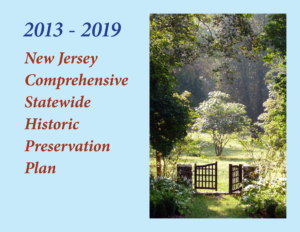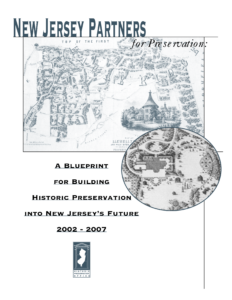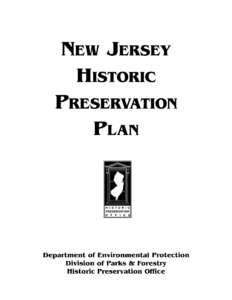Planning
Introduction
New Jersey, the most densely populated state in the United States, is diverse and in the midst of economic, cultural and demographic change. The approaches to preserving New Jersey historic properties are almost as numerous as the buildings, structures, sites and objects themselves. Tension always exists between the desire for new development and the desire to conserve what exists. The interest in preservation has grown and broadened, as has the concept of what should be preserved. Preservation planning helps in sorting out these complex issues by providing a framework within which sound decisions are made and effective actions are taken. Preservation planning is the rational, systematic process by which a community develops a vision, goals and priorities for the preservation of its historic and cultural resources. The community seeks to achieve its vision through its own actions and through influencing the actions of others. Goals and priorities are based on analyses of resource data and community values. Planning is a continuous process of identifying goals and priorities and finding ways to meet them.
Statewide historic preservation planning
Each state historic preservation office is responsible for developing a historic preservation plan, which is approved by the National Park Service in the Department of the Interior.
The New Jersey Historic Preservation Plan
Our plan, the New Jersey Historic Preservation Plan (NJHPP), has been in place since 1996. It has served to guide many agencies and initiatives statewide, such as
- Our office’s activities.
- Other agencies of state government, including through the New Jersey State Development/Redevelopment Plan.
- County and municipal governments and their respective historic preservation plans.
- Non-profit organizations.
- Others who may affect historic resources.
Collaborative planning
The planning process established by NPS requires broad-based public and professional involvement by
- Those interested in historic preservation.
- Individuals and organizations who make decisions about historic properties throughout the state.
As part of this effort, our office engages stakeholders and the public to gather input, information, and advice through a series of stakeholder workshops and public meetings.
Shared goals
The goals and objectives outlined in the Plan reflect the unique considerations of communities across the Garden State, as well as overarching themes and topics shared by many historic and cultural resource stewards across the United States. This provides the framework for how to
- Overcome existing barriers.
- Leverage opportunities.
- Improve stewardship of cultural heritage.
- Fulfill the overall vision for protecting New Jersey’s historic and cultural resources.
Our current statewide plan
HPO is pleased to provide the current historic preservation plan: New Jersey Comprehensive Statewide Historic Preservation Plan 2023-2028. This Plan explores and evaluates New Jersey’s history of preservation and presents a unified vision of historic preservation in New Jersey as individuals and organizations in New Jersey endeavor to protect and preserve New Jersey’s rich historic and archaeological resources for the future.
Our goals for 2023-2028
Strengthen and revitalize New Jersey’s state and local economies in a sustainable manner through historic preservation.
Goal 1 objectives
- Increase opportunities for economic improvement through historic preservation and more economic incentives that encourage historic preservation.
- Strengthen and align the preservation and environmental communities in New Jersey.
- Grow the heritage tourism economy in New Jersey communities.
Increase stewardship, support, and educational opportunities to protect the authentic places that tell the stories of New Jerseyans.
Goal 2 objectives
- Support New Jersey’s underrepresented historic resources through context development and the involvement of New Jersey’s diverse populations.
- Update and re-survey New Jersey’s historic resources, including
cultural, archaeological, and agricultural landscapes. - Increase opportunities for preservation in K-12 education.
- Increase support for local preservation through education
Foster a diverse, equitable, inclusive, and accessible preservation movement.
Goal 3 objectives
- Develop methods to reach new, diverse communities of New Jersey citizens.
- Increase representation of underrepresented historic properties in historic property inventories, surveys, and National Register nominations.
- Study and develop ways to identify and interpret intangible heritage as it emerges in the coming years as a critical advocacy point for historic preservation.
Increase integration of historic preservation into disaster planning and resilience.
Goal 4 objectives
- Gain a better understanding of historic properties in hazard vulnerable areas and their particular risks.
- Strengthen interagency coordination and relationships with local/state emergency management officials and responders.
Connect historic preservation to community planning efforts and strengthen local preservation.
Goal 5 objectives
- Expand historic preservation activities and collaboration with regional, county, and municipal governments.
- Educate public officials on the economic benefits of historic properties.
- Increase the number of Certified Local Governments (CLGs), which provide standard best practices for historic preservation as defined by the National Park Service.
Archived statewide plans
Planning resources
Local planning
Planning at the local level is a critical tool to preserve historic resources. Learn about including Historic Preservation Elements in Municipal Master Plans as part of local preservation programs.
Historic Preservation Planning Program (NPS)
Read about federal preservation planning and download guidance publications from the National Park Service.



